TRIP REPORTS & GALLERY
Visit to The Secret Bunker - 19th April 2018
Report and Images by Kate Luke
Our trip was blessed – first by being the first real day of spring and we had a new bus for our trip! Our driver, Paul, was from Fife and knew his way around – this was a huge relief as the Secret Bunker is situated in a quiet corner in Fife approximately half way between Rosyth and Leuchars…

We arrived and were greeted with a warm welcome and descended the first flight of stairs and along the main tunnel to the bunker – 150yds long and encased in 18inches of solid concrete. The entrance is through 2 massive doors which seal hermitically when closed.


We headed into the café for a welcoming coffee (or tea) in the former canteen – still decorated in the original colour scheme, Previously, the men were all served before the women – but now we were all served at the same time!

We divided into 2 groups, one group was taken a tour of the ops room where work was explained - conditions would have been very cramped – up to 300 people living and working in the bunker for up to a year had there been a nuclear attack. The other part of the group watched 2 flims, one general information on what to do and a 2nd which described the after effects of a nuclear attack.
The bunker was built, in the early 1950s and was where central government and military commanders would have run the country had the UK been attacked. It was built on 2 levels, 100feet below ground and encased in 13 feet of reinforced concrete.
The Secret Bunker was removed from the secrets list in 1993, it was then sold and first opened to the public in 1994.
After our lunch in the canteen, we climbed back out into the sunlight and on to the bus. We drove a short distance to Anstruther. We had about an hour and a half to wander or possibly visit the Fisheries Museum. The sun was shining and it was very pleasant to sit and watch the activity in and alongside the harbour.

I felt that I had had a very interesting day – the Secret Bunker was part of a national network that remained unknown for about 40 years. The effects of the Cold War had made this extraordinary construction seem necessary but it quickly became obsolete as the nature of war changed.
Anstruther was a very pleasant – and peacefu!- contrast!
=====================================================
Visit to Vikingar Largs - 12th September 2017
Report by Kate Luke
We met our Mackie’s bus in Stirling and headed to our Viking experience in Largs. Unfortunately, our route turned out rather more scenic than expected as we made a wrong turning and had to renogiate our way ….
We arrived safely in Largs in time for our tour of the exhibition. We were greeted by our Viking guide who led us into the longhouse. He gave an interesting and informative talk describing life in the longhouse – how it was arranged inside and how the different daily tasks would took place. As the climate could be very cold windows were closed by shutters and the smoke (and smells) would escape through a hole in the roof (as long as the wind was in the right direction!). The family’s animals also shared the space, being quartered for 17 weeks through the winter inside. The life was pretty hard, the flour for the daily bread took 6 to 8 hours to grind, then 24 hours to rise before being baked. The diet sounded varied – all home grown.
The long house held one family, the parents and the first son and his family, the brothers became Viking warriors and the sisters were married off.
The longhouse was set out, on a smaller scale, as it would have been. There were many examples of tools and articles of daily use on display and we were invited to inspect the exhibits and try on the helmets and some armour.
In the next area, Valhalla, we met some of the principal gods (wooden carvings on the walls) and their roles were explained; the God Odin explained his role in the life of the Vikings. In the next area we watched a 5-screen presentation of the family history of one Viking family up to the Battle of Largs in 1263. The last part was a walk through the “Hall of Knowledge’ which continued the Saga of the Vikings in Scotland
We had a short time in the gift shop before heading to Willowbank hotel for our lunch – lovely hot soup and sandwiches.
Our journey home was uneventful and the driver returned us safely and in good time at the car park. It had been a very interesting trip and our Viking guide had been both informative and entertaining. A big thank you to Donald Way for all his work arranging this trip.
=====================================================
Visit to Dalgarven Mill – Museum of Ayrshire Country Life and Costume 16th August 2017
Report and Photographs by Sandy Moreland
Our party of 40 left on a rather grey day for our trip to Dalgarven Mill Museum of Country Life. A enjoyable stop at Dobbies in Braehead Glasgow halfway on our two hour trip to the Mill was welcomed.
On arrival at the Mill Rob Ferguson, whose family have owned the Mill since 1923 when it was still a working grain mill, met us on the bus and gave us an introduction to the history of the Mill, a mill building having been on the site since 1203. Rob has now set up a Charitable Trust for the Mill and they have transformed it into what must be among the very best of country life museums in Scotland. The historic mill building has been beautifully restored and the large waterwheel, on a lade fed by the nearby River Garnock, works the machinery in the mill. All the machinery required to run a grain mill, a large collection of farm implements, old kitchen and dairy utensils, trade tools and many more country life artefacts are housed on three floors of the museum.
We were split up into two groups and Rob had prepared a programme for us to see all the wonderful exhibits he has on offer. Our group was taken first to an adjoining building store where they have a wonderful collection of period dresses, coats, hats and other garments donated by a wide range of supporters including Glasgow Museums and the Burrell Collection. Rob gave us a very entertaining account of some of the garments and their history.


Rob encouraged some of the party to try on some of the hats and coats much to the enjoyment of everyone.




There were two large cabinets both covered in black covers and at the end of this first display, Rob revealed the two prized exhibits which he said were not to be revealed (on pain of death) to anyone who had not visited the Museum. We will respect his wish in this report but two of the pictures might give a “Chinese Imperial Robes” clue!! Oh well my fate is sealed!!



We then went into the main Museum where on the ground floor was the current exhibition of Early Victorian Costumes, 1810-1865 entitled “Corsets and Crinolines”. The display of some of their vast collection of early Victorian wedding dresses was fabulous. We were joined at this point by one of his volunteers, a French seamstress who carries out remedial work on some of the dresses and she explained how she approached the work, particularly dealing with delicate silk material.

As we explored the upper floors of the Museum our group was most impressed by the extensive collection of farm equipment and country life artefacts. Much of the collection has been donated to the Museum by local farmers and other residents.


Rob Ferguson and Kate Luke

After our tour we retired to the Miller’s Kitchen Coffee Room to sample an excellent soup and sandwich menu, followed by some to the Saks & Hart Country and Period living shop. This was a fitting end to one of the Stirling Members’ Centre’s most interesting and enjoyable outings.
=====================================================
Visit to St Cecilia's Hall and University of Edinburgh Art Collection
19th July 2017
Report by Robert McKean Photographs by Robert McKean and Ian Watson
This trip, which was suggested by Ian Watson and organised by him, was one of the more unusual outings by our branch and one of the most enjoyable. Due to the confined location of St Cecilia’s Hall in the Cowgate, we were restricted to a small coach holding only 30 people. St Cecilia’s Hall was commissioned by the Edinburgh Musical Society and built by the architect Robert Mylne in 1763 in the Old Town of Edinburgh. It was the first purpose built Concert Hall in Scotland and the second in Great Britain. With the development of the New Town and the opening of the Assembly Rooms, the Concert Hall fell out of fashion and the last concert was held there in 1798. It passed through a variety of owners and purposes until 1959 when the University of Edinburgh purchased it to house its collection of historical musical instruments. The museum and Hall have just reopened after a refurbishment. On arrival we were split into two groups by the curator Sarah Deters. The first floor holds an array of early keyboard instruments from the 16th to the 18th centuries. Our enthusiastic and very knowledgeable guides explained the differences between spinnets, clavichords, harpsichords and pianofortes.



The guides also performed on several of the keyboards. We were also treated to a short recital on the organ in the Concert Hall itself.


The ground floor displays a wide variety of musical instruments. Once more the guides explained the origins and development of instruments such as the violin, tuba, bagpipes, clarinet and horn. The two and a half hours of our memorable visit passed all too quickly.

When we left the Hall, our bus driver took us to Chalmers Street. There we disembarked and members were left to choose a place for lunch. The chairman was last seen rushing to Blackwell’s book shop and when he returned to the bus after lunch was ladened down with books and a lot lighter in his wallet. In the early afternoon we were driven to Buccleuch Place where we disembarked for the University Library. There to welcome us was Neil Lebeter, the Art Curator of the University’s various collections. In a lecture room he gave us a most fascinating lecture with powerpoint presentation on the history and scope of the collections, which comprise the Fine Art Collection gathered by the University since its foundation in 1585 and those of the Edinburgh College of Art, which merged with the University in 2011 and consists of prints, drawings, and sculpture. To the surprise and delight of our members several items from the collection had been brought out of store for our inspection. Probably the highlight for many of us was the bronze Anatomical Figure of a Horse from the School of Giambologna c.1580s.

The University kindly gave each of us to take away a small guide book to the collections. In both these visits our enjoyment was made the greater by the evident passion and love for their subjects by our guides, all of whom seemed to be astonishingly young for their depth of knowledge. Perhaps this was just another sign of advancing years?
=====================================================
Visit to Kellie Castle and Hill of Tarvit, Fife
Thursday 15th June, 2017
Report and photographs by Robert McKean
The outing began rather inauspiciously as we left Stirling in rain and the driver
unfortunately took a wrong turning at Glenrothes, so that we had a mystery tour of central and eastern Fife. The chairman, who was the tour organiser, was to blame for this mishap, as he tempted fate by saying to members on the bus as we set off that we might be having a magical mystery tour of Fife in view of its many minor winding roads. However, once we reached Kellie Castle about forty minutes behind schedule, the sun came out and we had a fascinating and very enjoyable afternoon.


On arrival at Kellie we had a well informed guided tour of the castle, which was lovingly restored by the Lorimer family in the late 19th century. This was followed by an excellent lunch served in the medieval cellars. We enjoyed a choice of homemade soups, filled sandwiches and a cake tray. The chocolate cake was to die for! Kellie is famous for its 17th century Baroque ceilings and its walled garden. After lunch members had free time to walk round the garden or sun themselves in a secluded spot.


In the middle of the afternoon we went on to Hill of Tarvit, which was built by Sir Robert Lorimer, the architect of the Scottish National War Memorial at Edinburgh castle, for the Dundee financier and Jute manufacturer F.B.Sharp in 1904-1906. Each of the individual rooms was designed in an individual period style and furnished accordingly.

Thus there is Jacobean great hall, an 18th century French drawing room in the style of Louis Quinze and a dining room in Palladian style. The house is especially notable for retaining its original collections. Once more we were lucky to have a guided tour with two knowledgeable guides. Needless to say when we returned to Stirling in the early evening, it was once more raining.
=====================================================
Visit to Peebles & John Buchan Museum Thursday 18th May 2017
Report and Images by by Neil Pollock
The coach arrived early and we enjoyed a leisurely drive to Peebles with a break for morning tea/coffee at Dobbies near Edinburgh en route.
On our arrival at the Tontine Hotel our party of 53 were afforded a warm welcome by John Buchan’s granddaughter Lady Deborah Stewartby, Julian Birchall and Peter Worthington representing the John Buchan Story and Heritage Museum Trust. After settling in to the Adam Room our group was provided with most interesting presentations from all three on John Buchan, his legacy and the John Buchan Museum. Through his prolific writing and by his many contributions to public life, John Buchan was a highly influential figure and as a novelist, historian, journalist, politician, soldier and public servant, his influence can be seen in numerous areas of the first half of the twentieth century.

After a most enjoyable light lunch at the Tontine our party proceeded to 'The John Buchan Story' at the nearby Museum which explores Buchan's life and legacy, showing the variety and scale of his personal experience and literary output, beyond “The Thirty Nine Steps”. It also portrays his family's broader associations with Peebles and the Borders.



Then our party had free time to enjoy Peebles Town which has been a Royal Burgh since 1152. The town has a wide range of independent shops and it is lovely just to stroll along High Street, explore the alleyways and medieval closes and enjoy a walk along the River Tweed.
The weather had been extremely kind with the sun shining throughout and we boarded the coach somewhat weary but content. Well chauffeured by our driver Drew, we were totally untroubled by the traffic on the Edinburgh City Bypass!
*******************************************
Here is a sad report provided to our members on the outing by member Ian Cairns who also helped to organise the trip:-
Family of 39 Steps author
was devasted by three deaths from Arras.
Winston Churchill wrote condolences.
The Stirling Members’ Centre of the National Trust for Scotland recently visited Peebles to view the award winning museum devoted to the life and work of John Buchan. He is best recalled for his novel “The 39 Steps” but, in fact, wrote some 100 works of fiction and non-fiction and had a stellar career as a politician and statesman culminating in his appointment as Governor General of Canada and simultaneous elevation to the peerage as Lord Tweedsmuir.
An intriguing but sad local connection was discovered. Two days previously 46,000 poppies were dropped from the Wallace Monument, just outside Stirling, to commemorate the Fallen from the Second Battle of Arras which took place between 9th April and 16th May 1917. Three dead soldiers were closely connected to the Buchan Family.
For Britain and the Empire this battle achieved the most territorial gain since 1914. Alas, bad weather slowed the advance, the associated French advance failed, and the battle ended in stalemate. The significance for Scotland was that Arras involved more Scottish Battalions than any other battle in WWI. This led to the greatest single loss of soldiers from Scottish Battalions. Of some 159,000 British and Empire fallen, missing and wounded nearly one third, that is 46,000, were from Scottish Battalions. Within that number 18,000 fell or were missing in action.
Second Lieutenant Alastair Buchan, John Buchan’s younger brother, led his platoon from the 6th Royal Scots Fusiliers over the top on the first morning. He was hit almost immediately and died later that day in a Field Hospital. Winston Churchill, his commanding officer and then out of politics, wrote one of many letters of condolence. Churchill described Alastair as “.......a most charming and gallant young officer..........conscientious and much loved by his comrades.........”. Movingly, the Nurse who ministered to Alastair in his final moments kissed him before he was interred. She later wrote to Anna Buchan, his sister, saying that she did this in the absence of his Mother.
For the Buchan Family, and John Buchan in particular, Alastair’s death was immediately compounded. On the same day, also in the morning, and, about half a mile away, Tommy Nelson, his great friend, fellow student from Oxford and business partner in an Edinburgh publishing house, was hit by a shell and died instantaneously. Two days later Rev. Robbie Macmillan was killed. Robbie, serving as a Padre and a close friend of the Buchan Family, was romantically linked with Anna Buchan.
I H Cairns
19/5/17.
=====================================================
Visit to NTS Greenbank Garden & Britannia Panopticon Music Hall Saturday 29th April 2017
Report by Ian Watson. Images by Ian Watson and Sandy Moreland
A full bus-load of members left Stirling at an unusually comfortable hour – 10. 30 am - for a two part visit: NTS Greenbank Gardens, south of Glasgow, for the morning and then in the afternoon to Britannia Panopticon – the World’s Oldest Surviving Musical Hall - in central Glasgow.
It was a grey day but, despite it being a Bank Holiday weekend, we reached Greenbank Gardens in good time for a welcome cup of coffee with one part of our group in the tea room and the other in the coach house.
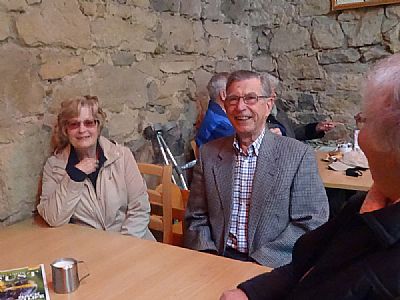

Thereafter there was time for us to wander on our own through the gardens before returning to the same venues for soup and sandwiches. The gardens were still in early spring mode but with signs of vigorous plant life all set out in a sequence of interconnecting rectangular areas.









Once in the centre of Glasgow (and having explained to the barbers in their premises on the edge of the car park that we were not queuing up for short back and sides) we were led through some less salubrious alleys of Glasgow, to one of the functional doorways into the Britannia Panopticon, up mysterious stairs and into the old hall itself – all dark and clearly indicating the tremendous amount of renovation that the worthy rescuers have taken on to return this relic facility to some state of rejuvenated glory.

At 3.15 the pianist began his superb transportation of the audience back to “the old days” performance of “Music Hall Memories” and at 3.30 the Master of Ceremonies welcomed us, explained briefly the hopes for restoration and then started the ball rolling introducing each segment with suitable thwacks of his gavel on the table.

It was an amateur company that entertained us in good fashion with comedy sketches, jokes and some music, all resonant of the 1950s. This clearly suited our members and others in the audience as we responded energetically with the required “oohs”, “ahs”, “nos”, cheers and even voices in “Put another nickel in” and songs made famous by Harry Lauder.



Thence back to the bus and home to Stirling. On the way back Chairman Bob McKean thanked Donald Way for organizing the day and Donald thanked the driver for his excellent driving.
=====================================================
Visit to Holmwood House and National Museum of Rural Life Wednesday 7th September 2016
Report and Images by Kate Luke
Our Mackies coach left Forthview punctually at 8.45am and we set off for our first stop, Holmwood House. Despite its historical interest, it is not well signposted but our driver, Brad, found it without difficulty and navigated the tight drive and entrance.
The site for the house was well chosen, on a hill, and surrounded by grass and trees and makes a statement – here lived a person of means.
 Holmwood House
Holmwood House
 Holmwood House
Holmwood House
We were met by our 2 guides, both volunteers, and divided into 2 groups – some to have coffee and the rest to have a guided tour. Both the guides were excellent and very knowledgeable about the building and the different people who had lived in the house. Holmwood House is currently undergoing an extensive restoration project and we were able to watch 2 conservators painstakingly removing layers of paint which covered the magnificent friezes which the architect Alexander ‘Greek’ Thomson had included in his plans for interior decoration. The house had been built for Mr James Couper who had made his money from a nearby paper mill, he wanted a building to entertain and impress his clients. The result is very impressive, although the bedrooms were very much plainer.
 Holmwood House Garden
Holmwood House Garden
 Holmwood House Garden
Holmwood House Garden
Safely gathered into the bus, we set off for our lunch stop at Caulders Garden centre – and travelled by the scenic route… We were very well looked after and had an excellent soup and sandwich lunch. Then off to the National Museum of Rural life – which was better signposted and a much easier entrance to drive into.
 Museum Building
Museum Building
This museum is a joint venture between the National Trust for Scotland who own the site and the National Museums of Scotland who manage it. The museum is large and has a varied range of exhibits – which include a working farm and farmhouse arranged as 1950s home. There are animals around the farm which are mainly rare breeds.
 Rare Breed Pigs
Rare Breed Pigs
 The Farmhouse
The Farmhouse
 Transport to the farmhouse – or a 10min walk
Transport to the farmhouse – or a 10min walk
In the museum are many examples of farm tools and show they have evolved 0ver 300 years of farming – tractors, harvesters, threshers and many other machines designed to make farming life more efficient and profitable – and how machines have replaced people in farming.

We returned to the bus and back to Stirling – witnessing massive road works around the end of the M8. I think that the day went very well – our driver, Brad, was wonderful, and we even had a dry day! Many thanks for all the members who supported our trip.
=====================================================
Visit to St Andrews University Wednesday 17th August 2016
Report by Margaret Moreland Images by Inger Johanne Pollock and Sandy Moreland
The Met. Office forecast was dry and sunny for the day of our trip to St. Andrews University and by the time we left Forthside Car Park an early morning mist was lifting and the sun beginning to shine through. After a very enjoyable drive to St. Andrews, with a brief stop at The Deer Centre, the day was all as promised by the weather men.
 Leaving the Deer Centre coffee break
Leaving the Deer Centre coffee break
On arrival, because we were a large party, we were split into two groups. In the morning Group A was first shown around the University’s museum by a very informative and enthusiastic guide who outlined the early history of the University and gave a brief account of several of the exhibits, the three maces being very greatly admired.
 The three St Andrews Maces
The three St Andrews Maces
 Modelling the St Andrews student gown!!
Modelling the St Andrews student gown!!
 Viva Voce with Bob (student) and Donald (master)
Viva Voce with Bob (student) and Donald (master)
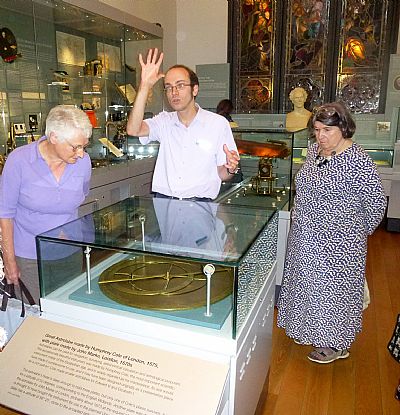 The Great Astrolabe made by Humphrey Cole 1575
The Great Astrolabe made by Humphrey Cole 1575
A guided talk in St. Salvatore’s Chapel, including an unexpected organ rehearsal, was greatly enjoyed by the group before heading to the Byre Theatre restaurant for lunch.
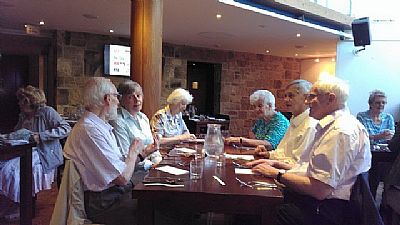 Lunch in the Byre Theatre restaurant
Lunch in the Byre Theatre restaurant
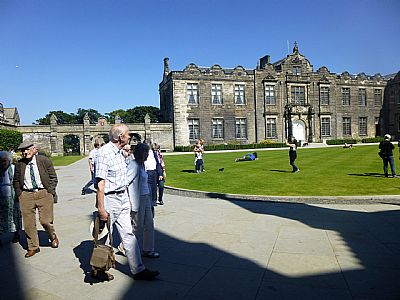 St Salvatore's College and the Quadrangle
St Salvatore's College and the Quadrangle
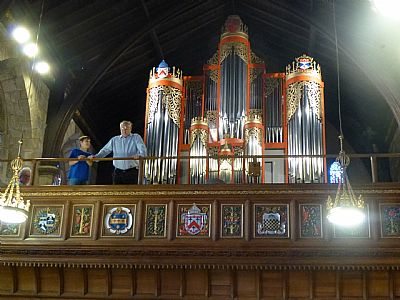 The St Salvatore's Chapel organist taking a break for our guided tour
The St Salvatore's Chapel organist taking a break for our guided tour
In the meantime Group B was given a guided tour of the Parliament Hall and Senate Room followed by a chance to wander around the gardens by St. Mary’s College and see the ancient thorn tree supposedly planted by Mary Queen of Scots.
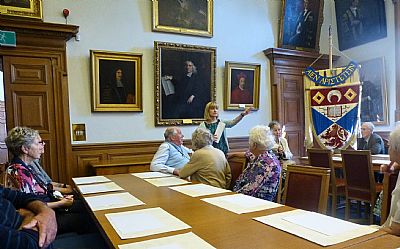 Our Guide in the Senate Room
Our Guide in the Senate Room
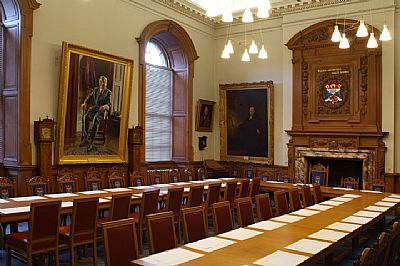 The Senate Room
The Senate Room
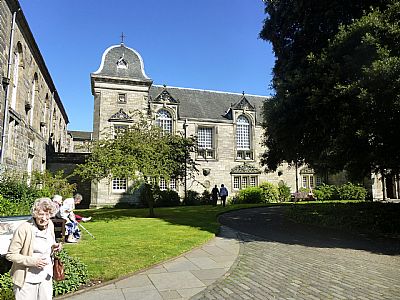 St Mary's College Quadrangle
St Mary's College Quadrangle
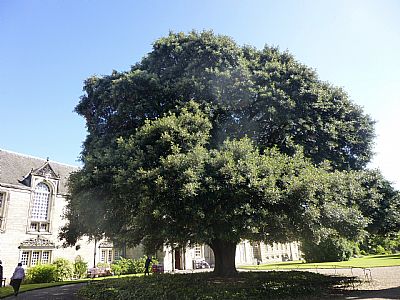 The Holm Oak in St Mary's Quadrangle planted about 1740
The Holm Oak in St Mary's Quadrangle planted about 1740
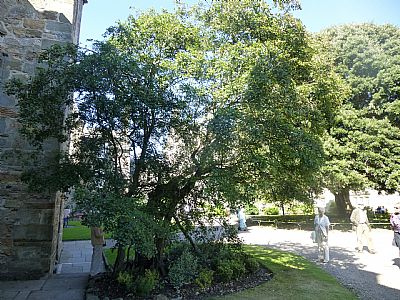 The Ancient Thorn Tree supposedly planted by Mary Queen of Scots
The Ancient Thorn Tree supposedly planted by Mary Queen of Scots
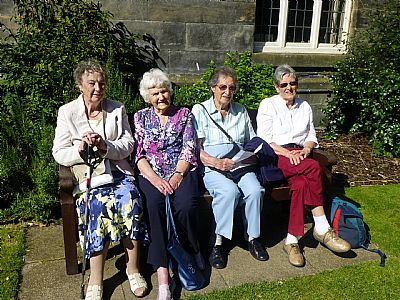 Taking the sun in St Mary's College Quadrangle
Taking the sun in St Mary's College Quadrangle
After lunch each group followed the programme enjoyed by the other in the morning, with Group A being lucky enough to have the elegant King James Library used by St. Mary’s students included in their afternoon visits.
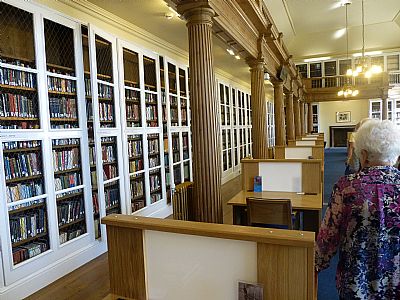 King James Library
King James Library
A scenic drive home in late afternoon sunshine completed a very informative and enjoyable trip to Scotland’s oldest university.
=====================================================
Visit to Blair Castle, Blair Atholl
Wednesday 20th July 2016
Report by Bob McKean
The Stirling Members’ Centre of the National Trust for Scotland held the fourth in its regular programme of summer outings to Blair Castle at Blair Atholl, Perthshire. Blair castle is the seat of the Dukes of Atholl and is set in an 145,000 acre estate. It is justly famous for its magnificent Georgian interiors with their stucco ceilings. The dining room and and the drawing room are particularly awesome in their magnificence. Our group left Stirling in thunder and lightning and torrential rain. As is usual on our trips we stopped for morning coffee at Dobbies outside of Perth.
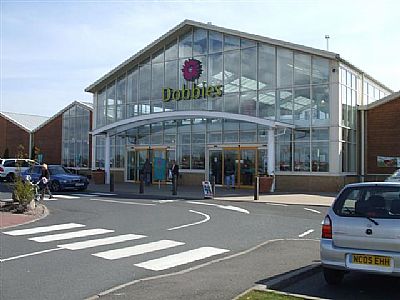
Luckily the rain ceased when we arrived at Blair so than from noon onwards we enjoyed dry, sunny weather. We were fortunate to be given a lengthy guided tour of the castle by a guide who was both informative and amusing.
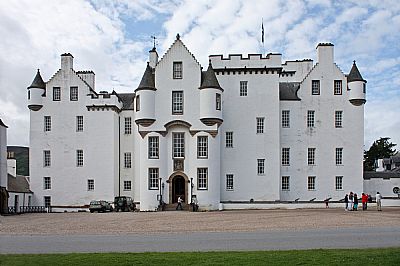
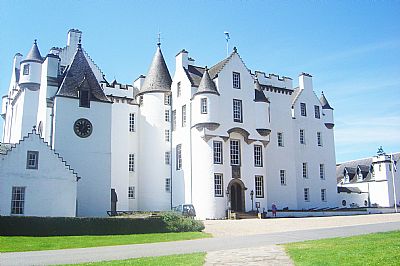
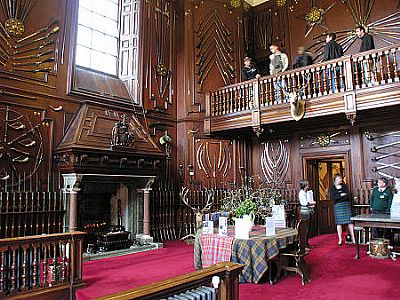
After the tour members had time to enjoy lunch in the restaurant or visit the gift shop, both of high quality, or take a stroll around the restored Hercules gardens or through the woods to see the ruined church where Claverhouse was buried after the battle of Killiecrankie in 1689.
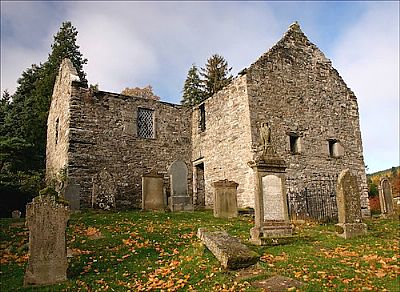
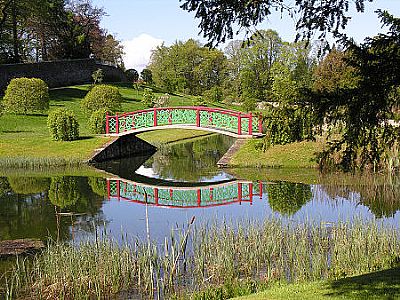
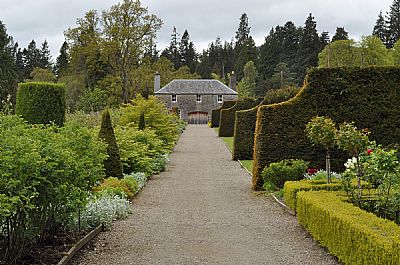
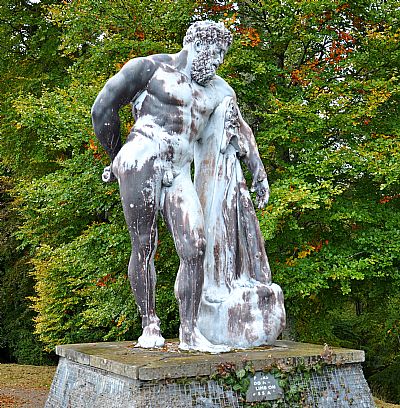
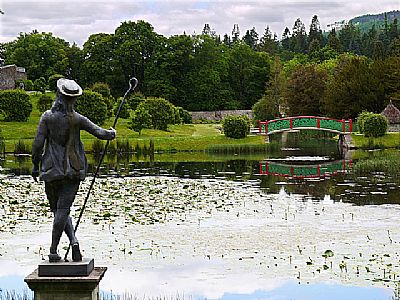
As our visit coincided with the World Scout Jamboree, we were also able to watch some of their activities. Thanks to the courtesy of our bus driver we had a splendid scenic drive back to Stirling in glorious sunshine through the Sma Glen.
=====================================================
Visit to Scone Palace and NTS Branklyn Garden, Perth
Thursday 16th June 2016
Report & Images by Neil Pollock
For our June outing we traded in our mid-morning tea/coffee stop for a later than usual departure time and travelled direct to Scone Palace the home of the Earls of Mansfield for over 400 years. On arrival we were treated to a most interesting tour of the Palace: whether it was porcelain, clocks, furniture, ivories or paintings our guide Christina had all the information at her fingertips.
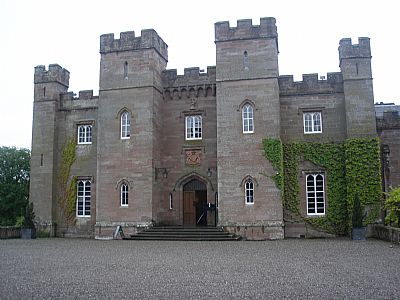
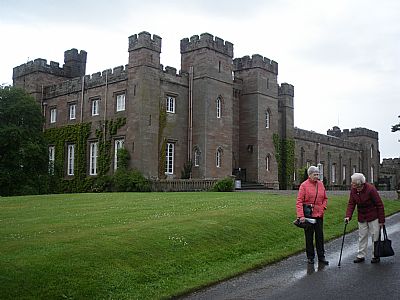
After a light lunch in the Old Kitchen most of the party explored the Palace further by visiting Queen Victoria’s magnificent bedroom. The Queen used the bedroom for one night only on 6th September 1842. We were told on the tour about the preparations which took place over two years in advance of her short visit. These included the creation of the present impressive entrance driveway constructed because Queen Victoria’s carriage would be too big for the existing archway – a problem a delivery driver experienced in 2010 when the archway was virtually demolished!
A few brave souls ventured outside in the rain to explore the grounds and Moot Hill the site of the ancient crowning place of Scottish Kings.
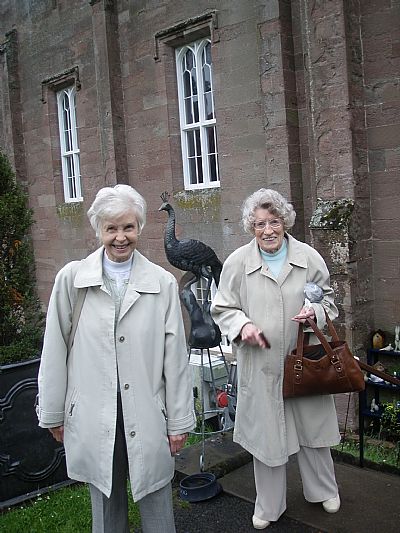
Robert the Bruce was crowned at Scone in 1306 and the last coronation was of Charles II, when he accepted the Scottish crown in 1651 nine years before he was restored to the English throne.
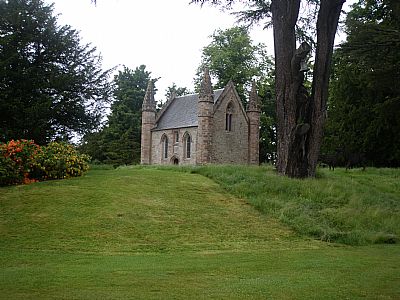
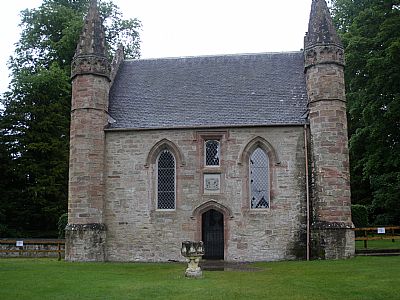
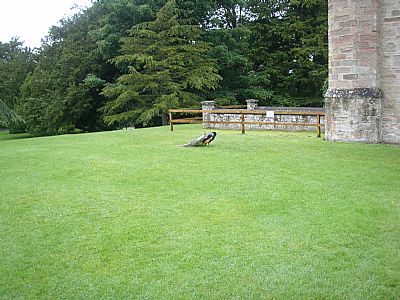
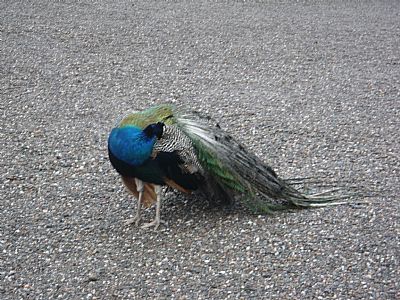
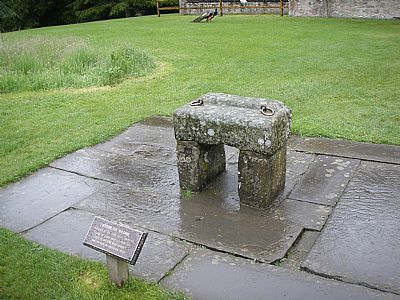
Then it was time to move on to Branklyn Garden created and developed between 1922 and 1966 by John and Dorothy Renton.
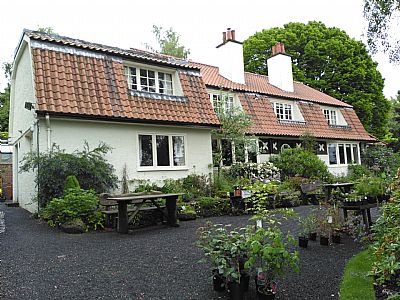
Fortunately the rain had subsided somewhat by the time we arrived and we were warmly greeted by Anette McNamara. For the last 18 years Anette and her husband Steve the Head Gardener have been running Branklyn on behalf of the Trust and much appreciate the support which has been provided by members of the Stirling Members’ Centre. They are due to retire later this year and we wish them well.
Originally a private garden and once described as ‘the finest two acres of private garden in the country’, Branklyn passed into the care of the NTS in 1966. The Garden holds an impressive collection of rare and unusual plants (notably rhododendrons and alpines) and is particularly fine in May and June.
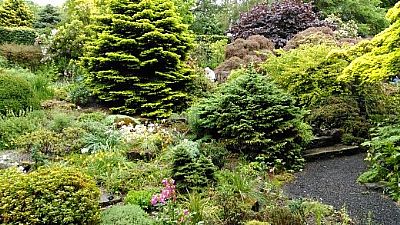
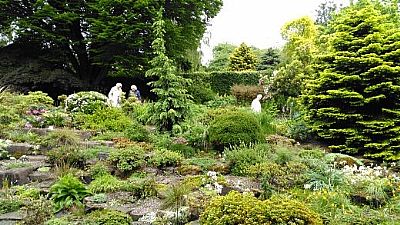
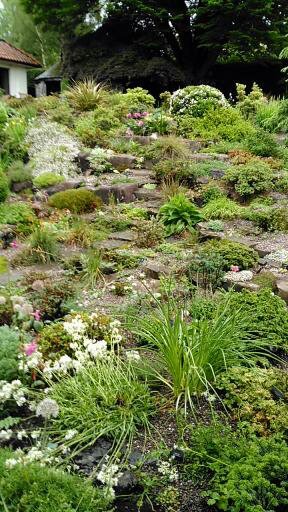
It certainly did not disappoint: several members boarded the coach laden with plants they had bought from the impressive collection on sale.
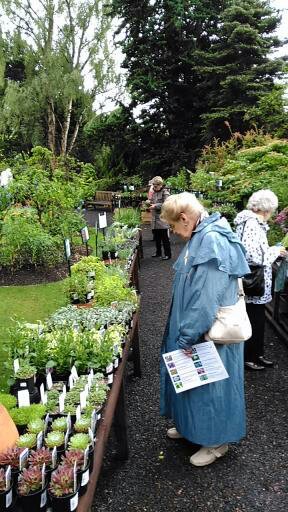
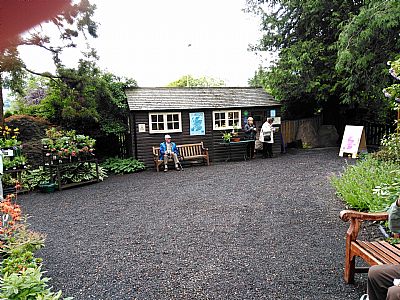
Once again Mackies Coaches looked after us very well and driver David brought us safely back to Stirling.
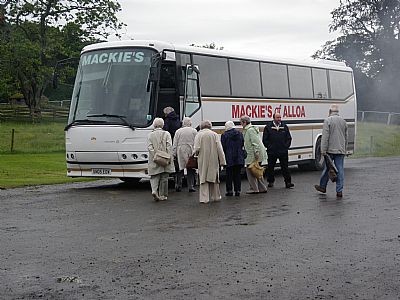
=====================================================
Visit to NTS Threave House and Garden
Thursday 19th May 2016
Report by Neil Pollock Images by Linna Monteath and Sandy Moreland
Threave Garden is a series of gardens created over the years by students of the Trust's School of Heritage Gardening. Since 1961 the School has been training future generations of gardeners in the fine traditions of Scottish Gardening covering the varied styles, locations and habitats.
On an unseasonably chilly May morning thirty eight hardy souls boarded our thankfully warm Mackies coach and headed south towards Dumfriesshire. Arriving at Threave around midday half the party proceeded to lunch whilst the remainder made for Threave House.
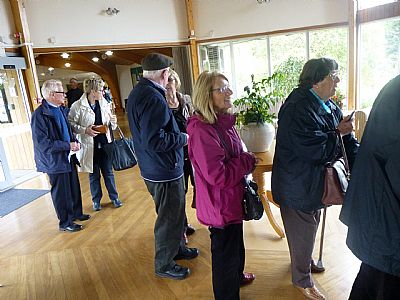
Booking in at Threave
William Gordon, a successful Liverpool businessman, bought the estate in 1867, and built the Scottish baronial-style house that dominates the garden. In 1948 William’s grandson, Major Alan Gordon passed the house and estate to the National Trust for Scotland. Many rooms are displayed as they were in the 1930s. Volunteer guides Yvonne and Marion provided an interesting tour of the four principal rooms and we heard more about the history of the Threave and the Gordon family.
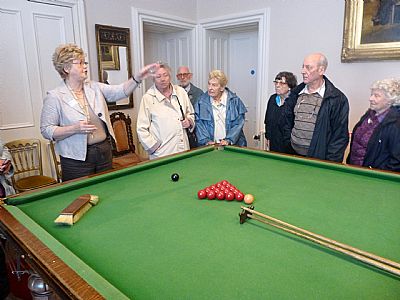
Yvonne describing the Billiard Room in Threave House
By the time both groups had viewed the House the rain had set in for the remainder of the afternoon. Nonetheless just over twenty brave souls assembled for the Garden Tour.
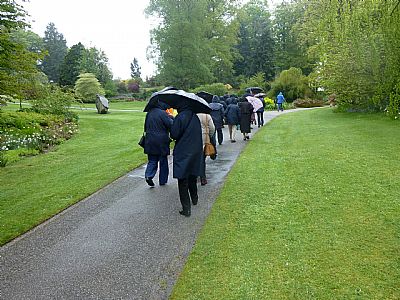
Well wrapped up!!
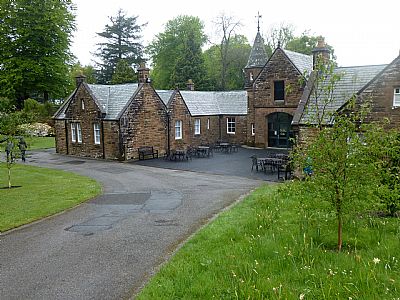
The new Stables Cafe!!
Their perseverance paid off because we were treated to a most interesting tour by Head Gardener Michael Lawrie and his colleague Brian who provided us not only with interesting information on the planting and various aspects of the Garden but also an insight into the history of the Garden and the training to RHS Standards provided to the horticultural students many of whom have gone on to occupy senior posts in other renowned gardens.
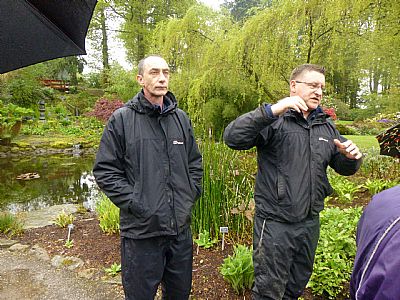
Michael describing the garden with Brian looking on
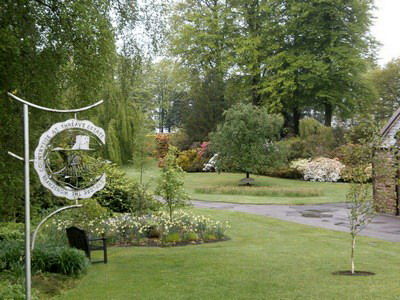
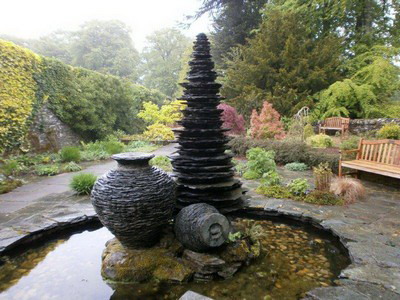
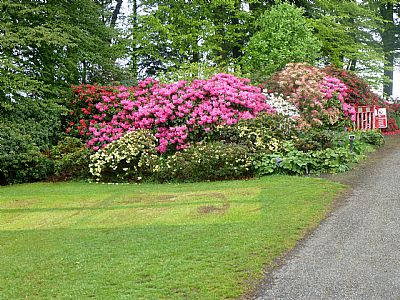
We saw the walled garden, secret garden and glasshouses together with a ‘behind-the-scenes’look at the preparation areas not normally open to the public.
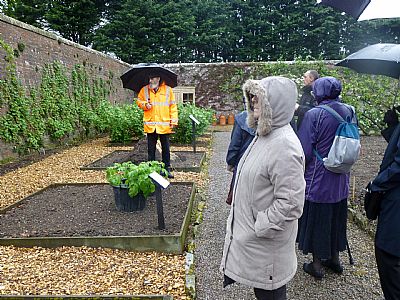
Brad our driver (in Yellow) was also interested in gardens!!
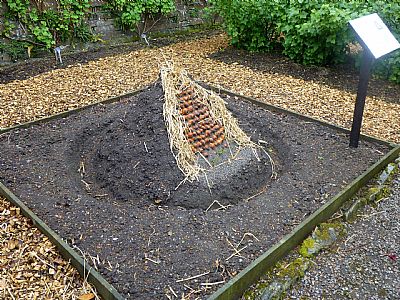
How to store carrots in the winter!!
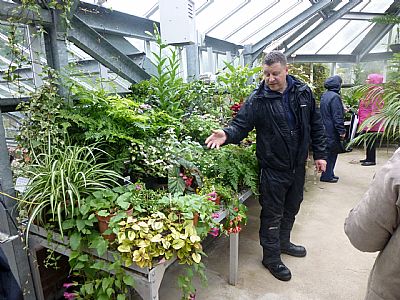
Michael in the Threave Glasshouse
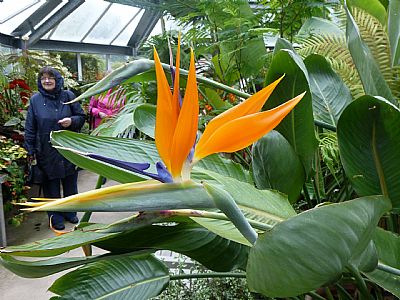
It is amazing that Threave Garden is maintained to such a high standard by only three professional gardening instructors six students (at one time they had funding for sixteen) and volunteers. What a valuable resource the School of Heritage Gardening is - let’s hope it is not victim to any more cutbacks!
=====================================================
Visit to Dumfries House
Wednesday 20th April 2016
Report by Ian Watson Images by Ian Watson and Neil Pollock
A new broom somewhere having (metaphorically) swept us out of our previous departure site, fifty-two expectant folk gathered with admirably good timing at the new departure site near Gabes eatery by the car park on Forthview Way. Sandy and Margaret had speedily researched alternatives, the committee had emailed their agreement and Neil had tackled the task of informing all of the change. Mind you, the downside – not too painful - is having to pay £1.40 for the day’s parking. Even at 30 minutes before departure time Mackie of Alloa’s bus was reassuringly there.
All safely aboard off we went and were soon appreciating the skillful driving of a new member of Mackie’s driving team, Brad. Hardly had we settled into our seats than we were stopping at Dobbies, Cumbernauld – something planned by Margaret and Sandy almost at the last minute. Forty five minutes later we were off again on the somewhat longer part of the journey to Dumfries House near Cumnock in Ayrshire arriving there in good time.
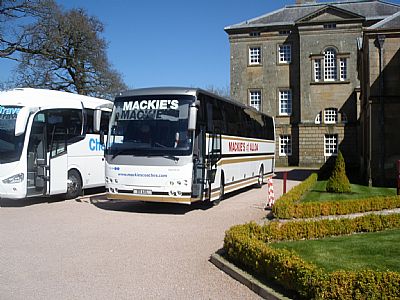
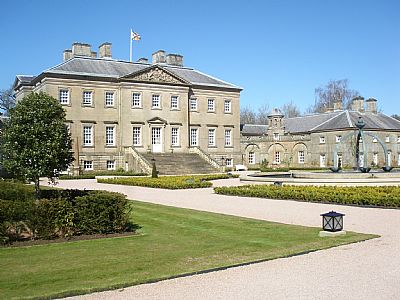
Not many people, on this trip at least, could have been unaware of how in 2007 Prince Charles had stepped in to galvanise raising enough finance to purchase Dumfries House, its contents and the estate even as Christie’s vehicles were on their way loaded with the famous Chippendale furniture for auction in London. The Marquis of Bute had been faced with two lots of crippling death duties and had finally given up waiting for other dithering parties to make him a realistic offer for treasures that should not be leaving Scottish custodianship. Margaret and Sandy thoughtfully provided us on the bus with printed sheets reminding us of Prince Charles rescue initiatives (not excluding a staggering sum from, effectively, his own resources) and outlining the subsequent stages which have taken place. We had further coverage of this when viewing a short introductory video by the Prince after lunch of soup, sandwiches and coffee in the Pavilion and before touring the house itself.
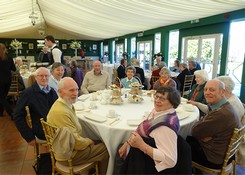
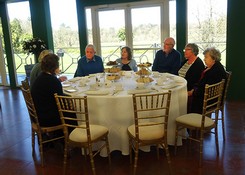
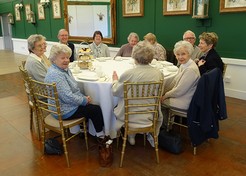
For the tour of the house, which was the one covering two floors, we were split into three manageable groups each with excellent, well informed guides. We were lucky also to be shown into the larger dining room which is not always open to the public. It was a long tour – 90 minutes – but worth it as we became increasingly aware the careful research, planning and expertise that has gone into the conservation and restoration of structure, décor and furnishings as well as the aesthetic and historical importance of what has and is being achieved.
Eye watering sums have money have been involved in the initial purchase and the projects that have been carried out. Prince Charles’ visionary support and continuously involved encouragement, together with that from the other members of the Great Steward of Scotland’s Dumfries House Trust and some incredibly generous donations and benefactions, are all much to be applauded and appreciated. There is more: the vision has not stopped at conservation and restoration; it has extended into many further projects utilizing the buildings and the land for a whole range of worthwhile educational and social ends. Real renaissance is afoot in this part of Ayrshire – but that is beyond the scope of this account of our day.
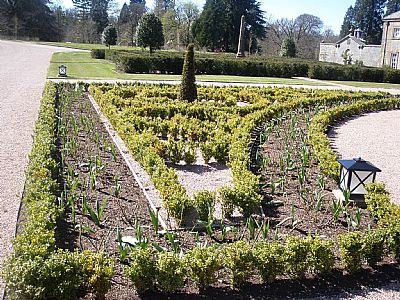
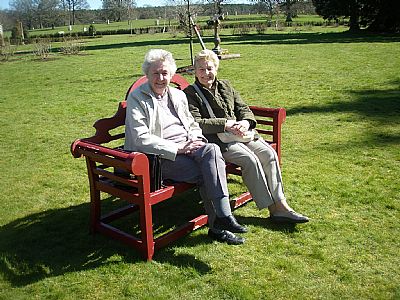
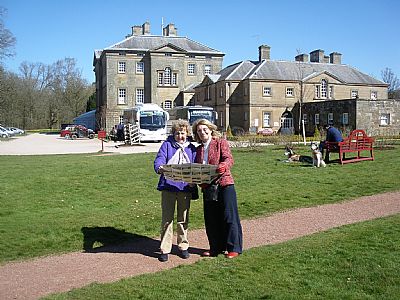
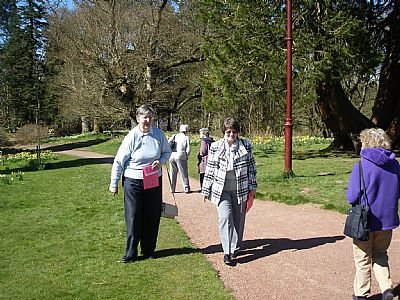
We clambered aboard our bus at 4 pm and, thanks to our driver’s sagacity, avoiding the rush hour traffic around Glasgow we were safely back in Stirling ahead of schedule. The sun had shone all day. It had been a well organised outing with a wealth of enlightening experiences. Thanks, of course, to our excellent Joint Secretaries, Sandy and Margaret Moreland.
=====================================================
Visit to Dundee – The McManus Galleries and Discovery Point
Thursday 17th September 2015
Report by Neil Pollock Images by Ian Watson
We set off in our Mackies coach from Stirling on a fresh autumn morning. Our first port of call was Glendoick Garden Centre where we were treated to an excellent morning coffee/tea with scones and tray-bakes followed by the mandatory opportunity for some retail therapy.
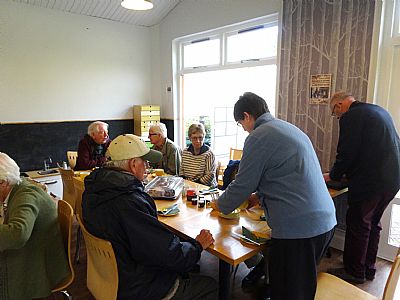
Shall I be mother?
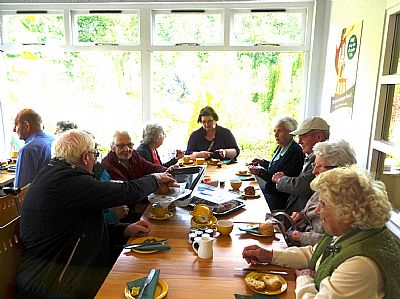
The Chairman enjoys the last scone!
Then it was onward to the McManus which is Dundee’s Art Gallery and Museum located near the City Centre. Designed by George Gilbert Scott in the Gothic Revival Style the McManus opened in 1867 as the Albert Institute. It was subsequently enlarged and now houses exhibitions in galleries ranging from the Victoria Gallery and Dundee & the World to the 20th Century Gallery and the Making of Modern Dundee. Many choose to take the interesting ‘taster’ tour guided by Rod Gordon and intend to return at a later date to spend more time exploring the collections.
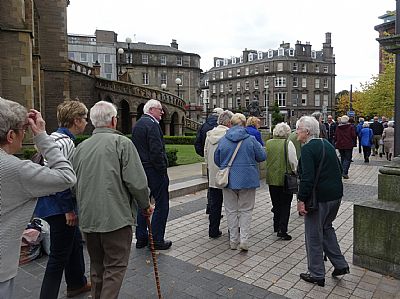
Follow the Guide
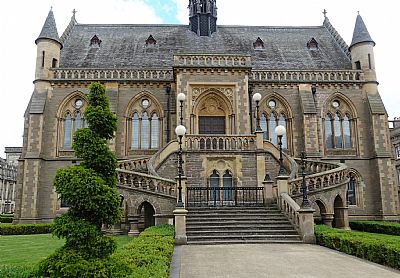
The McManus
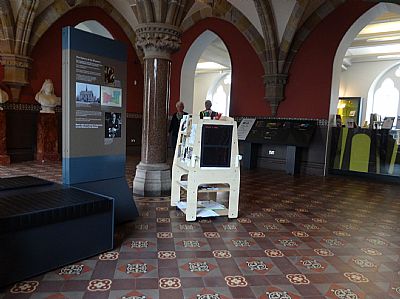
The McManus Interior
No time to tarry though; the coach had returned to take us to Discovery Point where after a light lunch at the café we went on a tour of the exhibitions and a guided tour of the Royal Research Ship Discovery. She was built at Dundee in 1901 for the British National Antarctic Expedition to be used for magnetic surveys and carrying out meteorological, oceanographic, geological and biological research. Captained by Robert Falcon Scott Discovery set off from Britain in August 1901 and five months later arrived in Antarctica. She then became locked in pack ice and it was not until February 1904 that she was freed with the aid of two rescue ships and explosives which were detonated to release the ship. Fortunately the ship was designed with an extremely thick oak hull to enable it to withstand the pressures of ice which almost certainly would have crushed a weaker vessel.
Discovery returned to Britain in September 1904. Much of the work carried out during the expedition was groundbreaking - many new kinds of marine creatures were discovered. The coastline, mountain ranges and glaciers were mapped. All this was carried out in extreme conditions. The body of research filled ten weighty volumes published by the Royal Geographic Society.
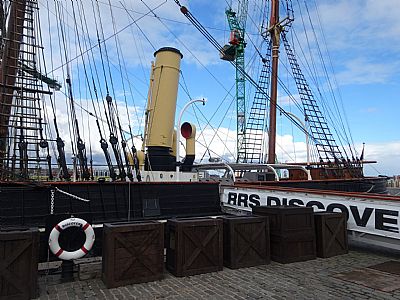
RRS Discovery
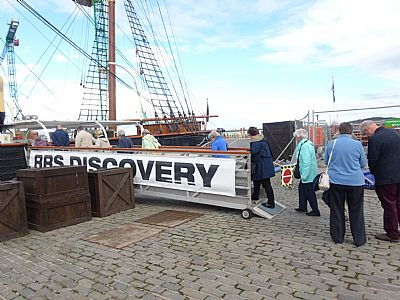
All aboard!
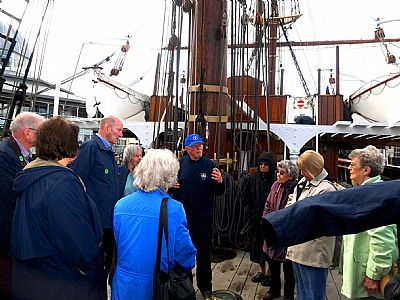
Our Guide - Stewart
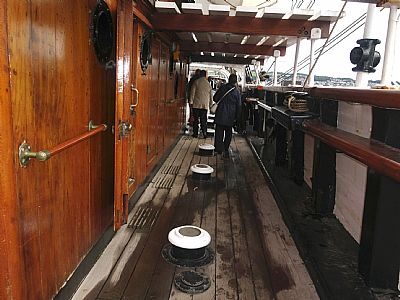
The "Ankle Bashers"
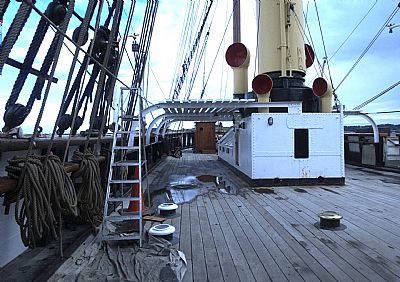
Towards the stern
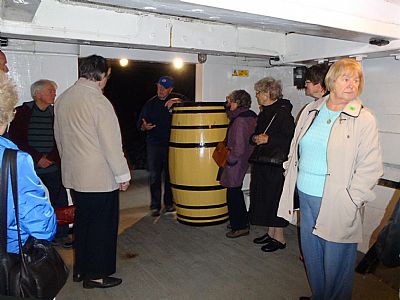
The Crow's Nest
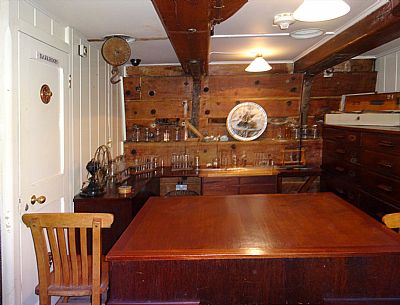
Below decks
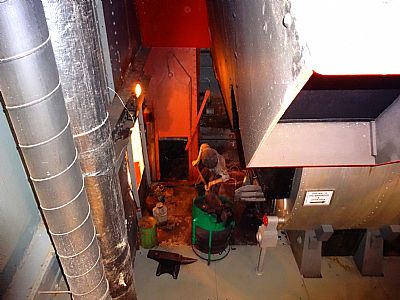
Stoking the boiler
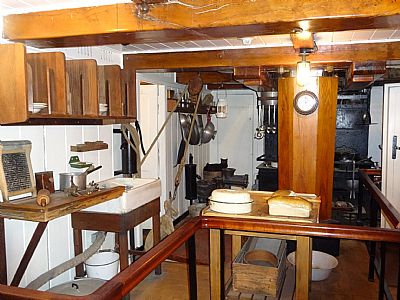
The Galley
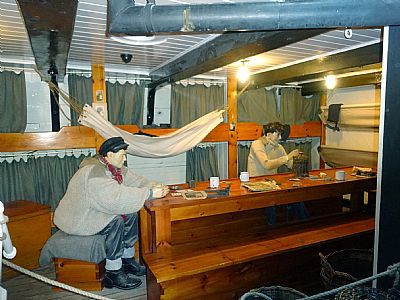
The Crew relaxes
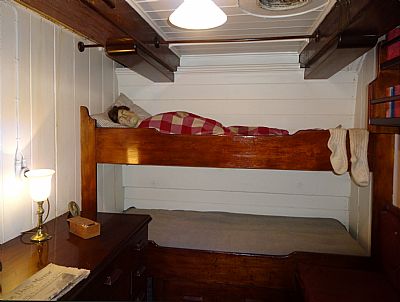
I don't feel well!!
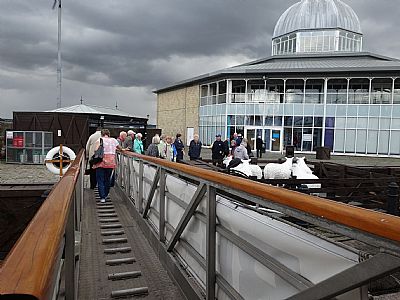
Time to disembark and head home
Our excellent guide Stewart gave us a graphic account of life on board in confined and cold conditions. He explained there were no portholes for fear of weakening the hull and light was let into the ship through mushroom vents on the decks known as ‘ankle bashers’.
Our own motley crew all had a good ‘work-out’ descending well below decks and scrambling back up again. All too soon it was time for us to disembark and head back to Stirling.
A satisfactory end to our Summer Programme of outings for 2015.
=====================================================
Visit to North Berwick and Dirleton Castle & Gardens Wednesday 12th August 2015
Report by Neil Pollock Images by Jim Mitchell & Neil Pollock
The weather was somewhat indifferent and chilly when 44 Members and Guests boarded the Mackies coach which transported us smoothly to North Berwick along part of the scenic route.
We arrived close to the beach and Seabird Centre and dispersed - some to explore the town and shops, some for an early lunch whilst others relaxed with a picnic and enjoyed the scenery. When we reassembled for our short onward journey to Dirleton, the sun had come out and many were enjoying an ice-cream and even seeking shade!
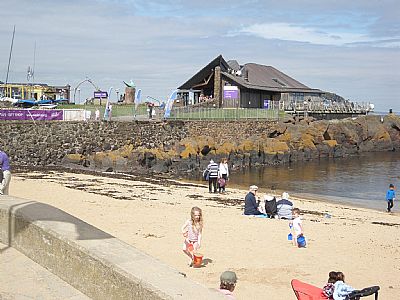
The Seabird Centre
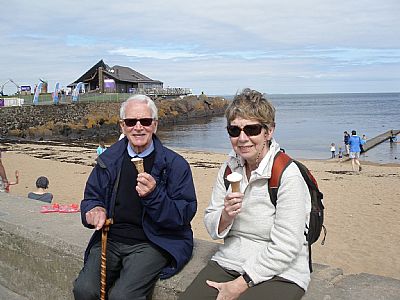
Enjoying an ice cream!
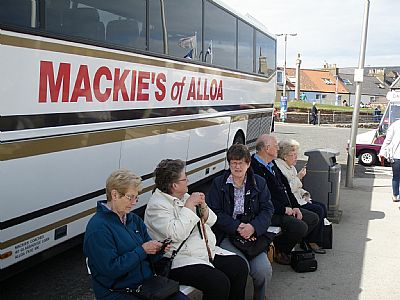
Chatting in the shade
By the time we reached Dirleton Castle the sun was spotlighting the Castle and Gardens.
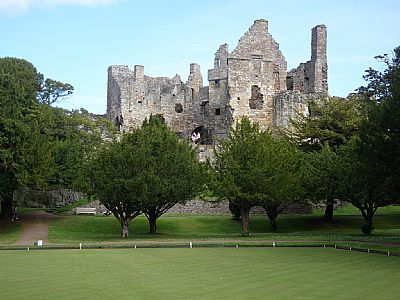
The Castle from the Bowling Green
The Gardens include the longest continuous herbaceous border in the world. There are many specimen trees and a sunken bowling green which was probably originally a parterre. The formal planting of the 1860’s Victorian Garden was recreated by Historic Scotland in the 1990’s whilst the Arts and Crafts Garden dates from the 1920’s: all are maintained to an impressively high standard.
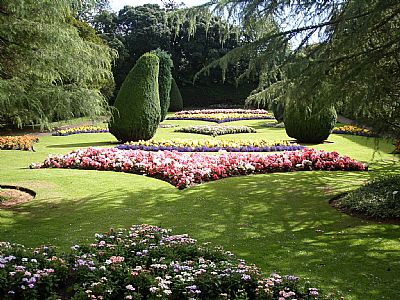
The Victorian Garden
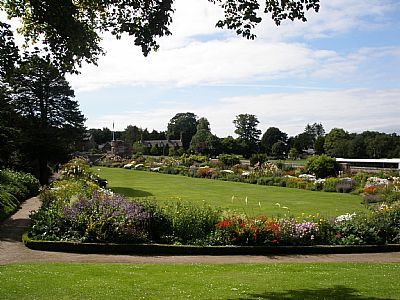
The Arts & Crafts Garden
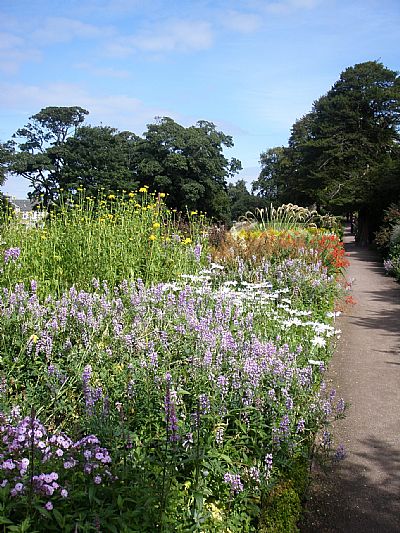
The world’s longest continuous herbaceous border
Some of our party opted for the Garden Tour where we heard about the history of the various gardens on the site over the centuries including the plants grown - many for medicinal purposes. The tour included a visit to the 16th century Dovecot which used to house around 2000 pigeons. The young were harvested for food and the droppings on the floor were gathered and used in the making of gunpowder.
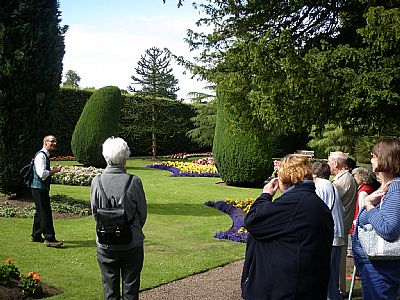
The Garden Tour
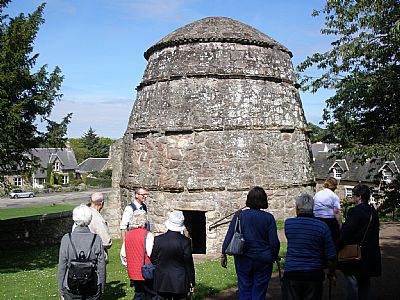
The Dovecot
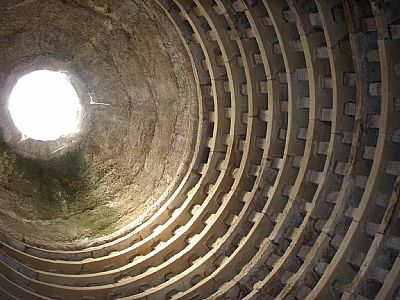
Where the pigeons enter
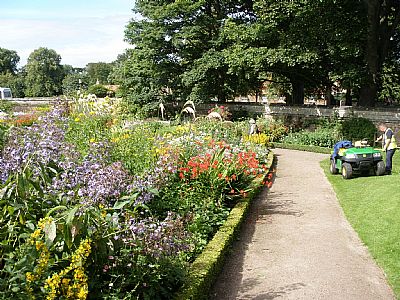
Gardener at work!
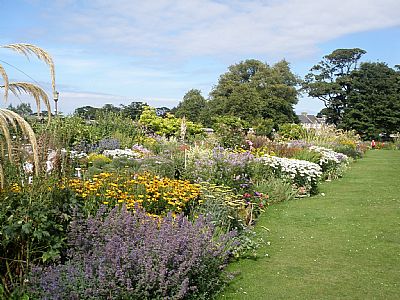
What a border!
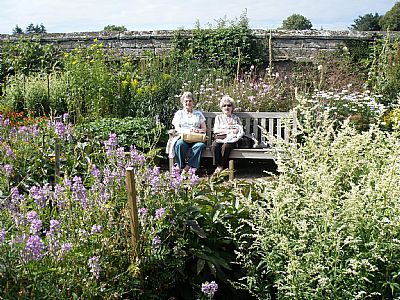
Relaxing in floral heaven
Then it was onward to the Castle – a substantial ruin with plenty of atmosphere. Parts of the structure date from the 13th century and over the centuries it was a residence of three noble families the de Vauxes, Haliburtons and Ruthvens. Oliver Cromwell’s forces laid siege to the Castle in 1650 and thereafter it was abandoned as a residence. Subsequent owners built a mansion nearby and the ruins became a feature in the landscaped grounds as they remain today.
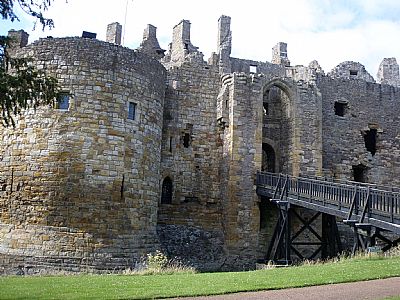
The main entrance
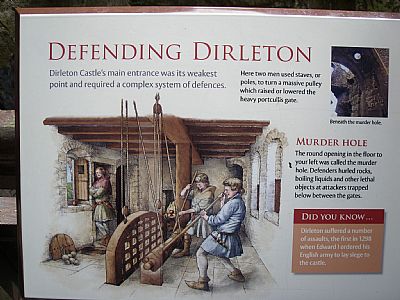
Defending Dirleton
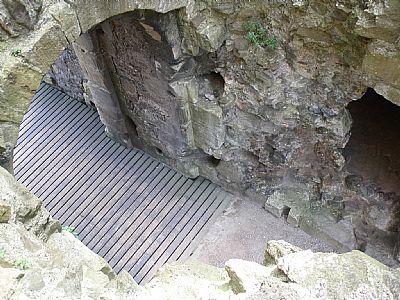
Castle entrance from above
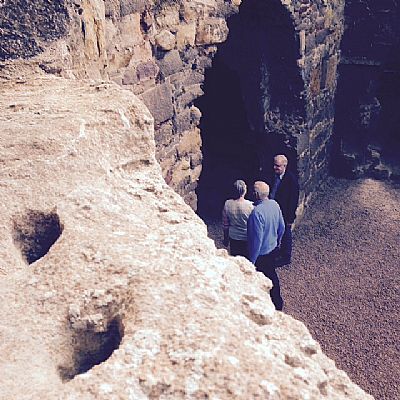
Meeting at the entrance
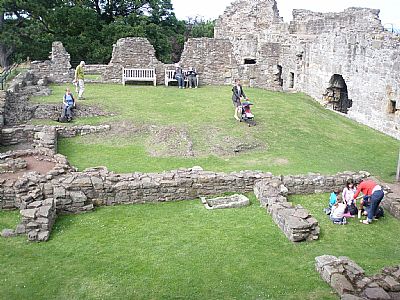
The Courtyard
We departed content, well chauffeured by our driver Robert and totally untroubled by the traffic on the Edinburgh City Bypass!
=====================================================
Visit to Mellerstain House Wednesday 8th July 2015
Report and Images by Ian Watson
A rather smaller number than usual (35) clambered into the bus at a moderately civilized hour (09.30) and were transported off to the Borders (stopping en route at Dobbies for coffee, comfort restoration and ritual nose powdering - or whatever) for our visit to the home of the Earl and Countess of Haddington (not that we were to be meeting them in person).
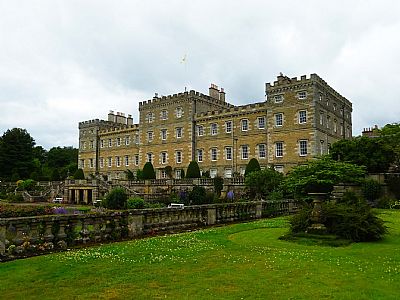
Mellerstain House
Mellerstain is not normally open on a Wednesday so we were the fortunate beneficiaries of an exclusive lunch (excellent vegetable soup, sandwiches, cake and coffee or tea) followed by guided tour in two sub-groups of 17/18.
William Adam designed the original, opposite wings but it was the central, later, palatial section, designed by his probably more famous son, Robert, which is the main focus of the tour. Here there has been hardly any significant change to the outer appearance and inner décor. There was a lot to admire by way of architectural detail, furniture and many a portrait by famous and not so famous painters to view and, perhaps, to wonder that so many aristocratic Scottish ladies of yester year appear to have had the same facial features!
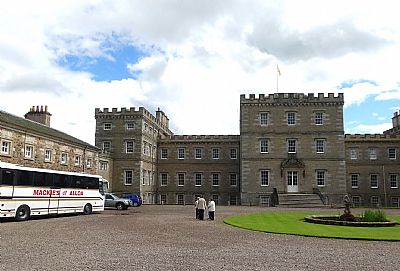
North & East Wing
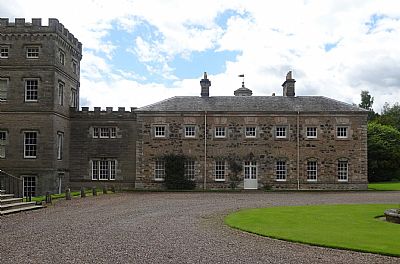
West Wing
There was time also to wander through the grounds and enjoy the beautiful, superbly maintained gardens and the delightful vista southwards to the lake, before setting off again to return to Stirling.
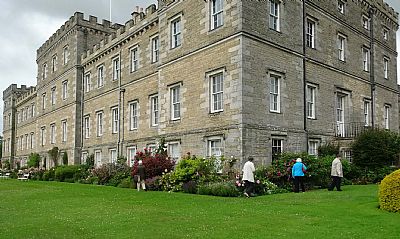
Flower Beds
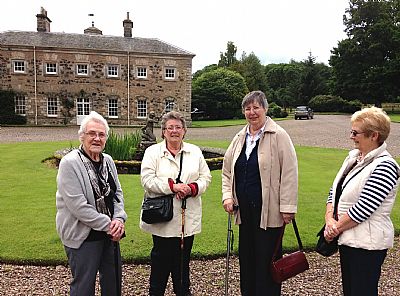
Some Lady Trippers
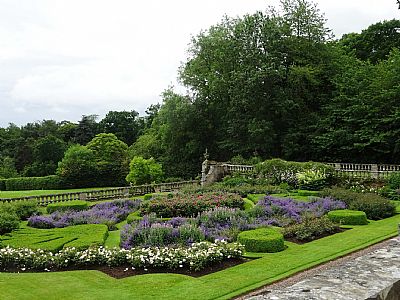
Terrace Garden
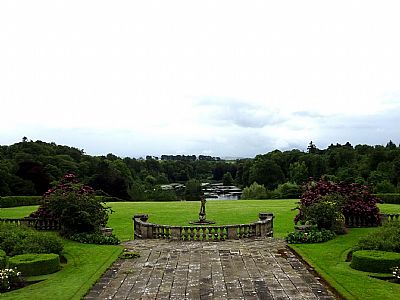
View from the Terrace
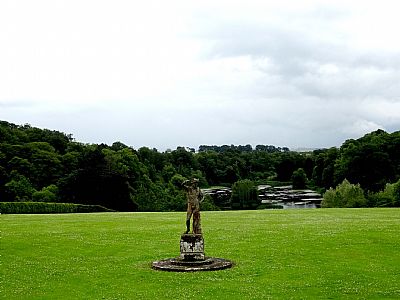
Lake from the Terrace
Our bus driver is to be commended for his quiet competence in getting us there, aligning the bus so that it would go through the narrow gateway into the Mellerstain grounds and for choosing an alternative route back to avoid the road works at Earlston. It was a delightful outing for which we owe much to Bob McKean for his arrangements and good humoured organization of the day.
=====================================================
Visit to Dunstaffnage Castle, Argyll Wednesday 17th June 2015
Report by Neil Pollock Images by Ian Watson and Jim Mitchell
A full coach load of members and friends braved a ‘somewhat earlier than usual start’ from Stirling heading up the A84/85 through glorious countryside. After a short stop in Tyndrum we continued to North Connell where we enjoyed lunch at the Lochnell Arms Hotel in a Dining Room which overlooks the swirling waters of the Falls of Lora.
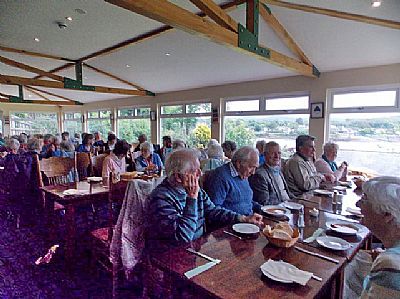
Lunch at the Lochnell Arms
Thereafter we continued the short distance to Dunbeg and Dunstaffnage Castle through a twisting road and narrow gates and driveway which proved no problem whatsoever for the excellent driving skills of John our driver.
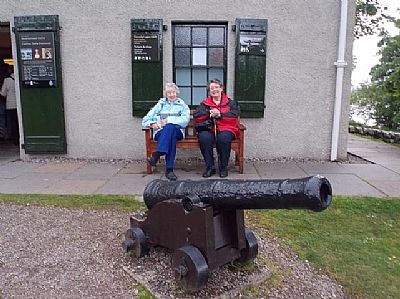
Two ladies of leisure
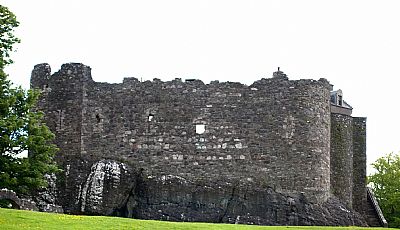
A ruin but still impressive
Historic Scotland’s custodian gave us a brief history of the Castle from the time of its construction by the MacDougalls in the 13th Century when the threat was mainly from the Norwegians. The MacDougalls owned it until defeated by Robert the Bruce in 1309 when ownership passed to the Crown and then from the late 14th Century to the Campbells.
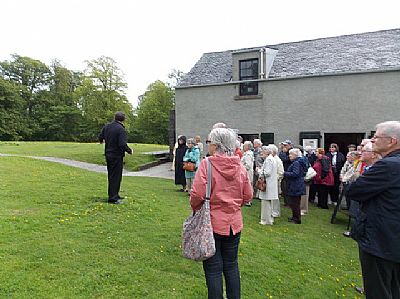
The introductory talk
Flora MacDonald was briefly imprisoned at Dunstaffnage whilst en route to imprisonment in London.
Then we had plenty free time to explore. The steep climb up to the castle proved well worthwhile: with its strategic location on a promontory at the south-west of the entrance to Loch Etive, the castle and grounds are surrounded on three sides by the sea and the views are magnificent.
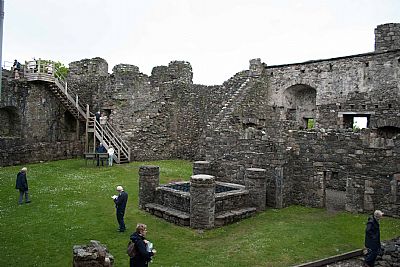
Overview of the castle yard
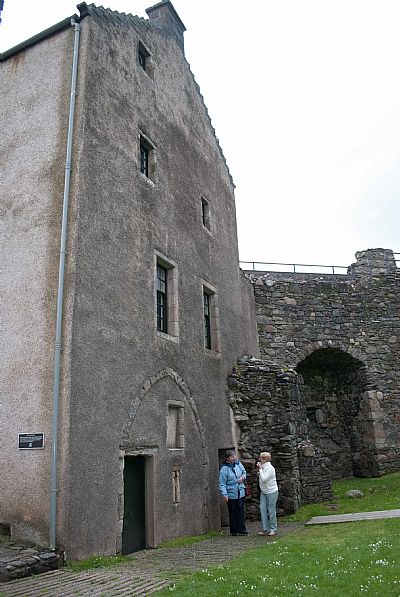
The gatehouse
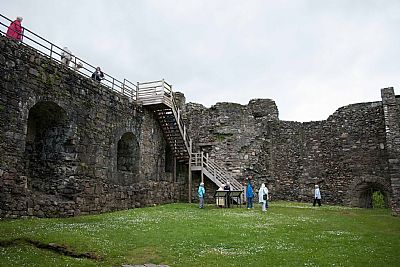
Another climb to the battlements
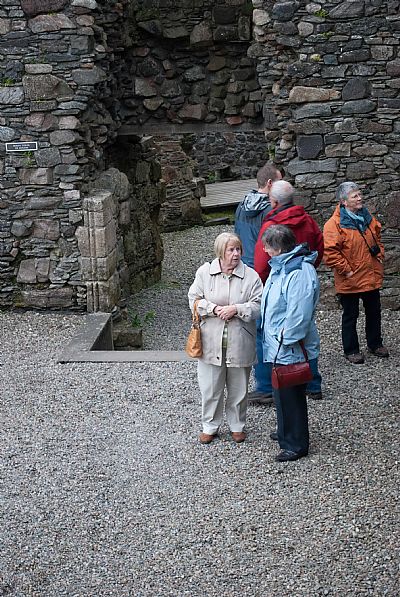
Deep in conversation
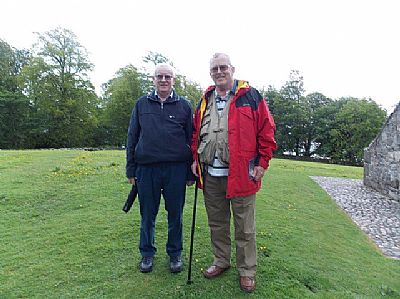
Bob & Jack
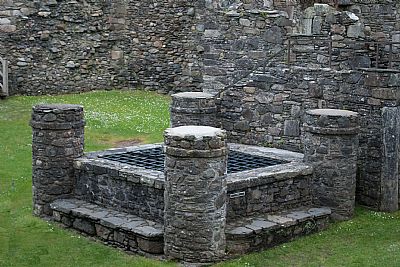
The well
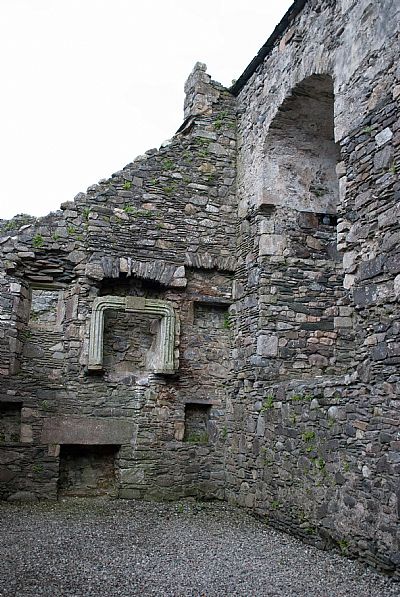
Whats that fireplace doing up there?
Some of us also visited the ruined chapel to the south-west of the castle which features detailed stonework of outstanding quality.
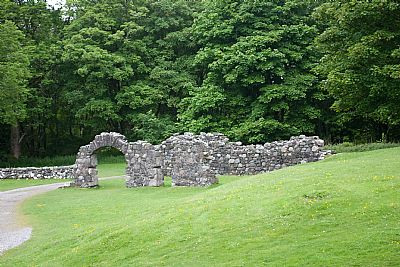
The stables and the route to the chapel
The return journey provided yet another opportunity to enjoy the spectacular scenery.
All in all another successful outing.
=====================================================
Visit to Glamis Castle, Angus Thursday 14th May 2015
Report by Neil Pollock Images by Neil Pollock - Additional images by Ian Watson and Sandy Moreland
Our first port of call on our itinerary for the May outing was Glendoick Garden Centre where we all enjoyed a generous morning tea /coffee and a shopping opportunity.
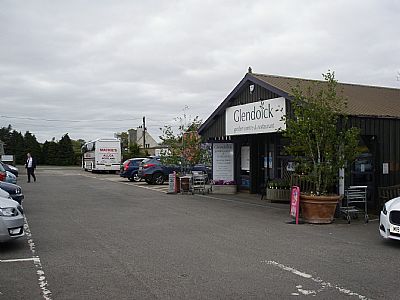
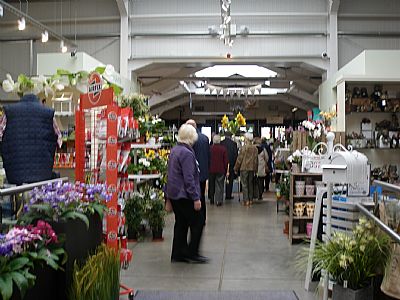
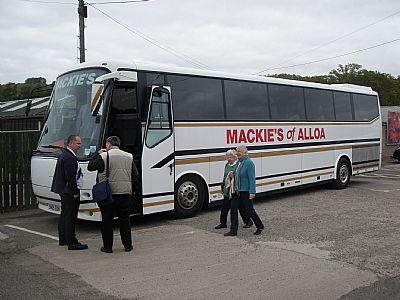
Then our driver Stuart took us for a pleasant drive through the Perthshire and Angus countryside to Glamis and specifically the Strathmore Arms Country Inn where most of the party had opted for the optional lunch which certainly did not disappoint!
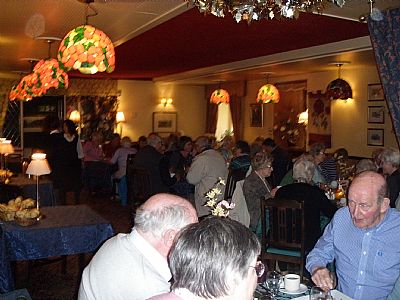
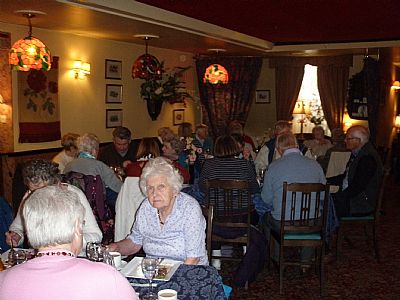
Then ‘oh-so-well’ fed it was onward to the Castle arriving via the magnificent approach down the tree lined drive.
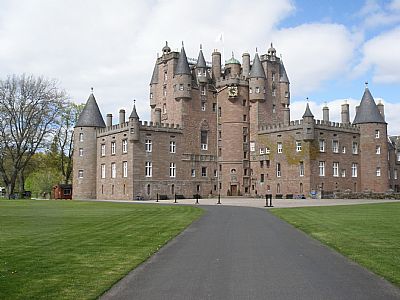
On arrival we split into two parties for a 50minute guided tour. No photography was allowed in the Castle. The present building dates from the early 15th Century with various additions and alterations to satisfy the requirements of the Strathmore family but the original tower house remains at the centre of the present Castle.
We were entertained with the guide’s stories of the lives of the inhabitants over the centuries some of whom are said to haunt the place. Magnificent furniture paintings and wall hangings were all on display. One of the highlights was the chapel which has an intimate atmosphere and is little altered from the 1680s. The ceiling and walls are adorned with paintings by Jacob de Witt.
Glamis Castle is of course famed for its Royal Connections as being the childhood home in Scotland of Her Majesty Queen Elizabeth The Queen Mother and birthplace of HRH The Princess Margaret. We were shown the apartments the Queen Mum used when she visited along with the room nearby which Mary Queen of Scots must have used on the occasion of her visit in 1562.
After the tour we had time to relax and enjoy the scenery, and explore the gift shop
or take a walk past the Pets Cemetery ........
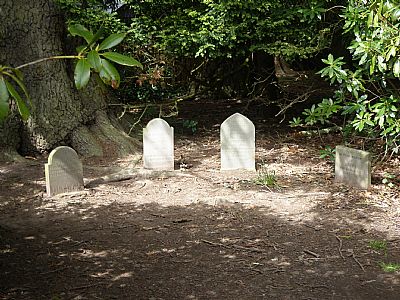
through the Italian Garden dating from 1910
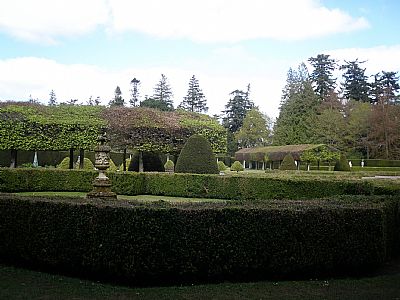 #
#

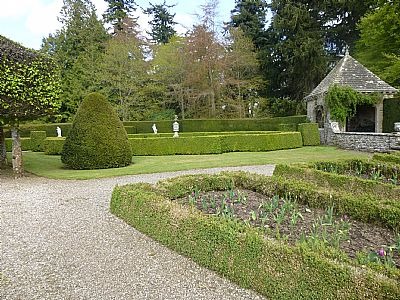
past the Monument to the late Princess Margaret
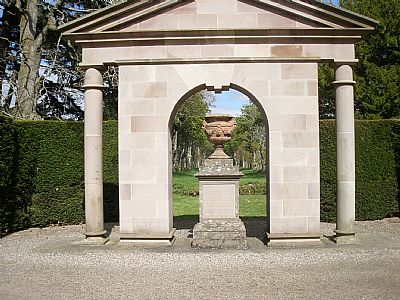
through the Pinetum planted in 1864
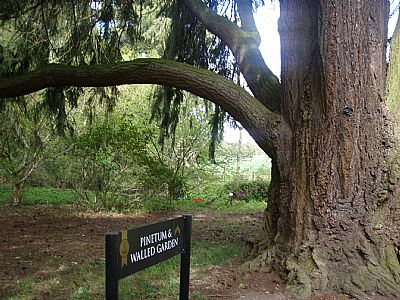
observing wildlife if we were lucky (this deer appears to have recently given birth to a tiny fawn)
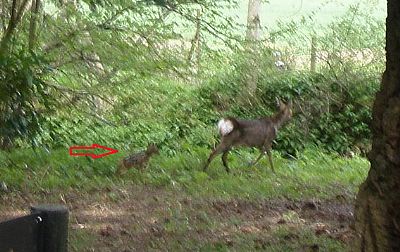
to the Walled Garden which is currently undergoing major redevelopment.
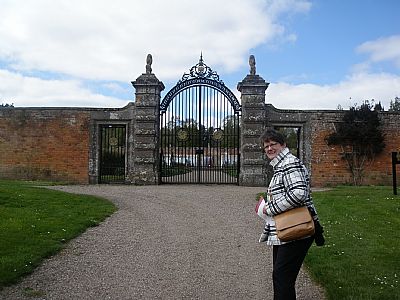
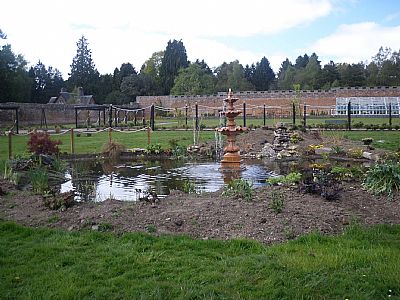
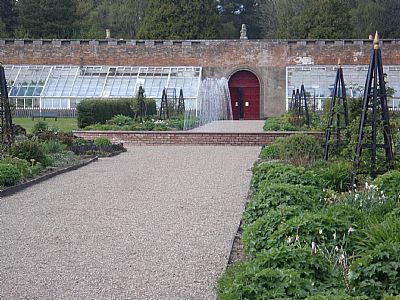
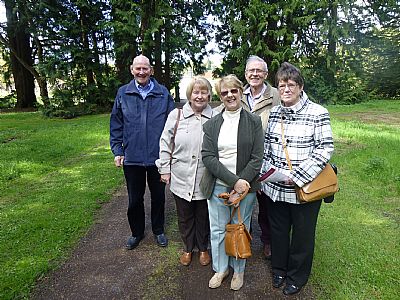
.... and back to the sundial.
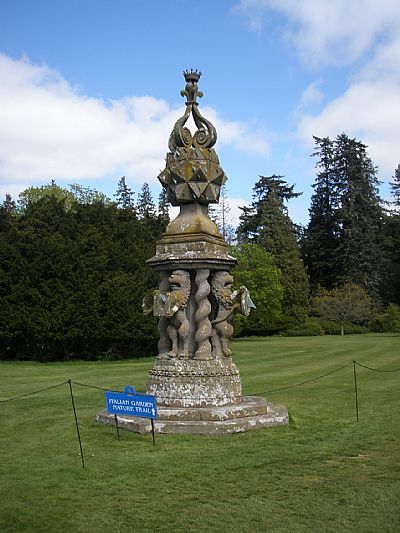
The day was rounded off with Stuart chauffeuring his very contented passengers home to Stirling via Coupar Angus and Perth.
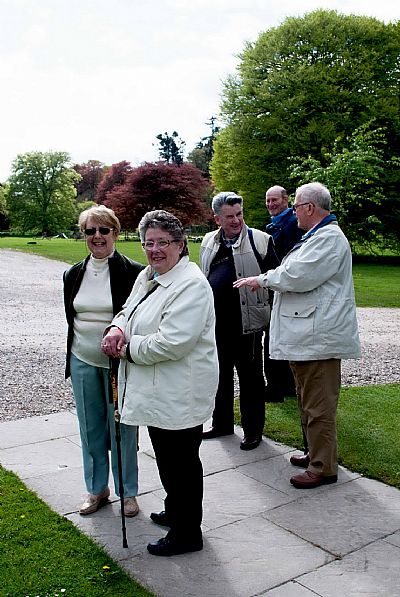
=====================================================
Visit to the National Mining Museum of Scotland. Midlothian Wednesday 22nd April 2015
Report and images by Neil Pollock
For our first outing of the season we were blessed with glorious weather. We arrived at the National Mining Museum in good fettle after lunch en route and split into groups for our tours.
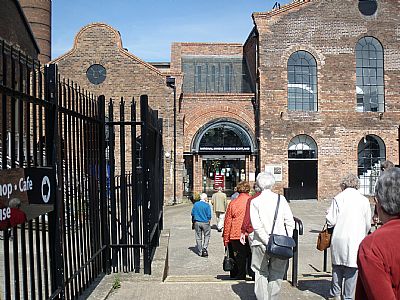
Our arrival
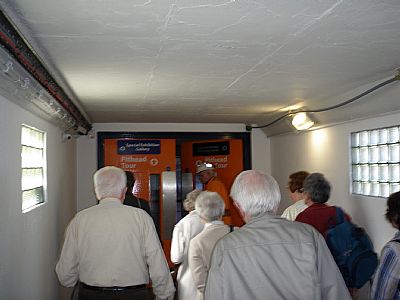
Making our way to the Pit Head
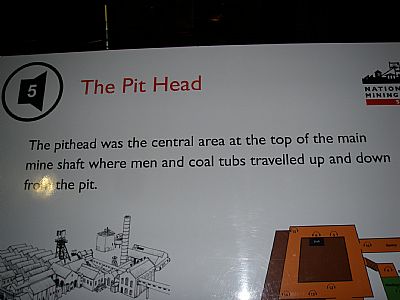
At the Pit Head
During the Big Stuff Massive Machinery Tour we were shown the Museum’s extensive collection of large mining objects, such as coal cutters, cages, and locomotives.
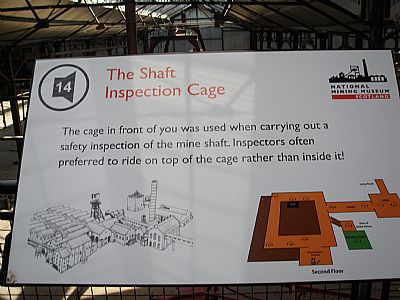
At the Shaft Inspection Cage
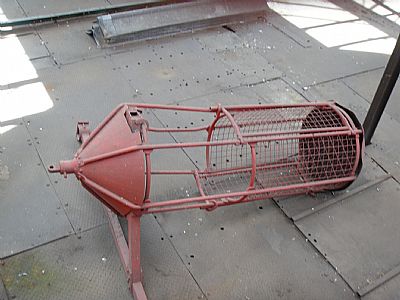
The aforementioned Cage!
During the Pithead Tour we learnt much about mining life generally and in particular the Lady Victoria Mine which was in operation from 1895 to 1981. Over this period there were huge changes in the method of extraction at the coal face: from the miners crouching often in cramped conditions using picks and the use of ponies (in this mine until 1923) to the highly mechanised equipment of today. 1500 miners were employed in this mine.
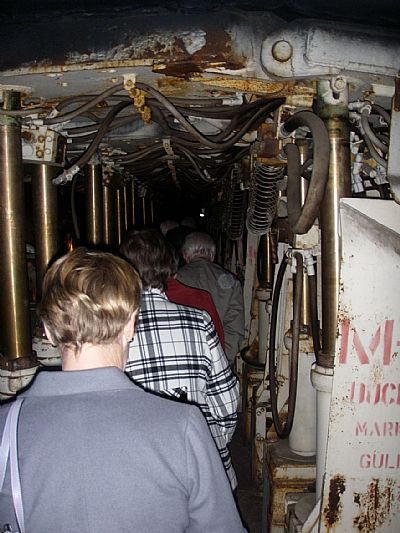
We reach the Coal Face
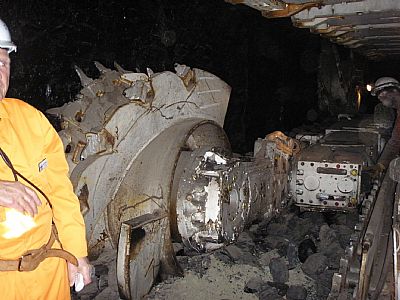
Modern Cutting Equipment.....
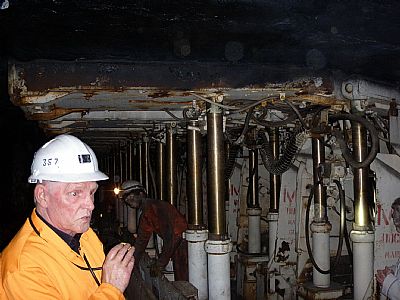
.....and Hydraulics to shore the roof up!
One of the highlights included the demonstration of the most powerful steam winding engine in Scotland. Victorian engineering at its best.
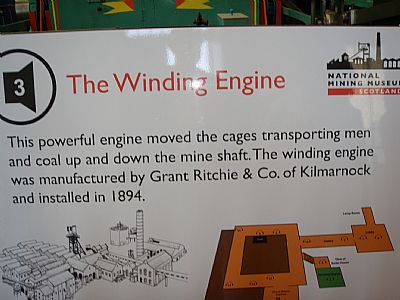
At the Winding Engine
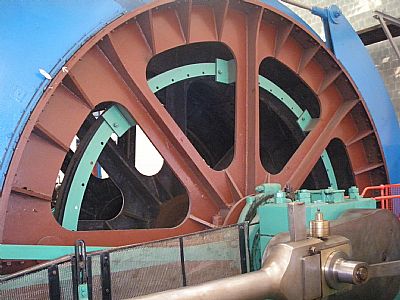
The Winding Engine
Work was hard and the dangers considerable with risks of gas, explosion, flooding and collapse. Prior to the introduction of the Davy lamp canaries were used to aid the detection of noxious gases. We were introduced to some canaries whose two immediate predecessors had been called Arthur Scargill and Maggie Thatcher!
The great grandfather of one of our guides had been a miner at the Lady Victoria Mine when it opened in 1895 and this guide had been a miner when it closed illustrating how the mining tradition ran in families.
The former miners who acted as our guides are real characters enthusiastically relating their industry’s history often with more than a touch of humour. We all left with a much deeper understanding of mining industry and its history.
All in all a thoroughly enjoyable day’s outing.
=====================================================
Outing to Abbotsford House, Melrose
Wednesday 13th August 2014
Report by Neil Pollock and images by Ian Watson and Sandy Moreland
After our usual mid-morning coffee break en route at Dobbies near Edinburgh fifty two members and friends enjoyed a pleasant drive as our coach headed towards the Borders arriving at Abbotsford just in time for lunch.
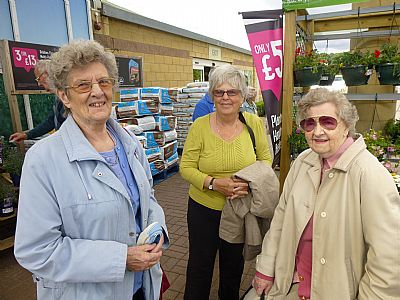
Waiting for the bus at Dobbies
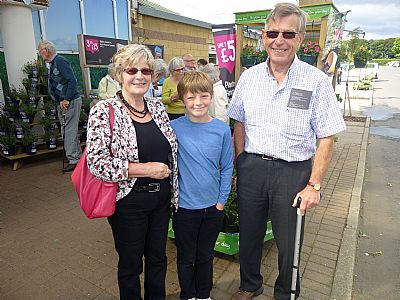
Our youngest member, Hector with his Grandparents
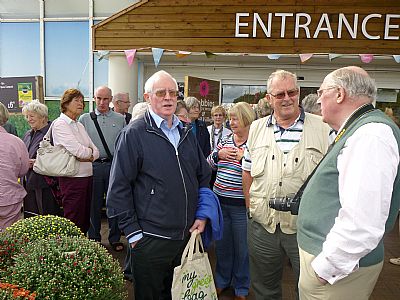
Waiting for the bus at Dobbies
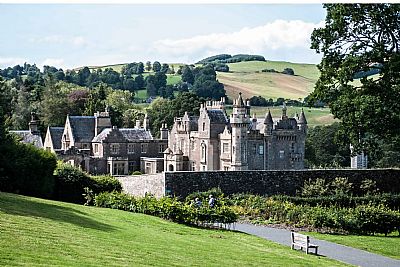
Walking down to Abbotsford
The house reopened last year after an extensive programme of repair and refurbishment. Most of our party lunched at the impressive new visitor centre which includes the reception shop restaurant and exhibition.
We then made our way in two groups down to the house where two very knowledgeable guides gave us a tour of the house.
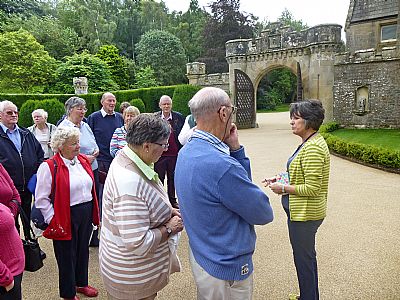
One of the guides with our group
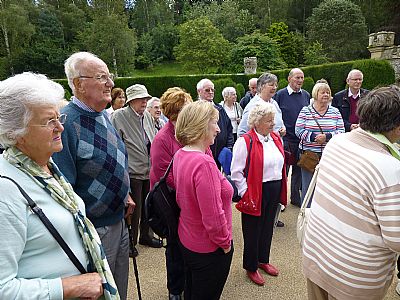
Our group listening intently to the guide
Sir Walter acquired a farm on the site in 1811 and renamed it Abbotsford after the ford across the Tweed below the house used in former times by the monks of Melrose Abbey. Abbotsford was built in three phases: the first from 1817-19; the second from 1822-25 and the third in the 1850s some 20 years after Scott’s death. Scott was an eclectic collector and his home was filled with an astonishing collection of artefacts, objects and treasures many of which inspired his writing.
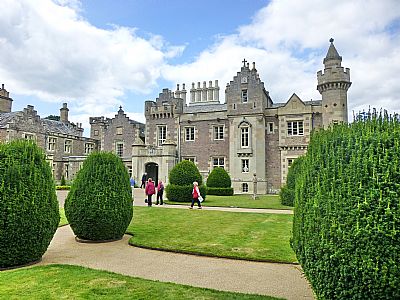
Abbotsford House
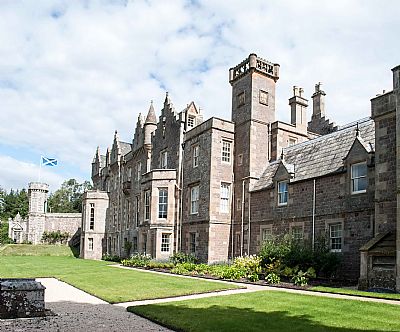
Abbotsford House
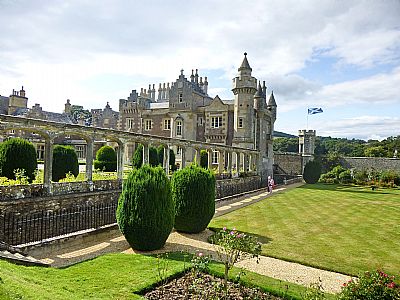
Abbotsford House and Gardens
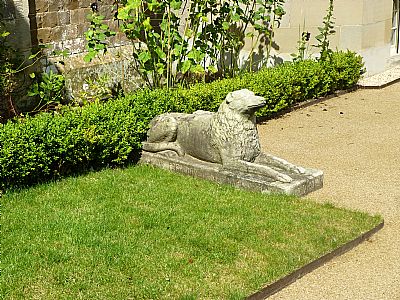
Sir Walter Scott's favourite dog "Maida"
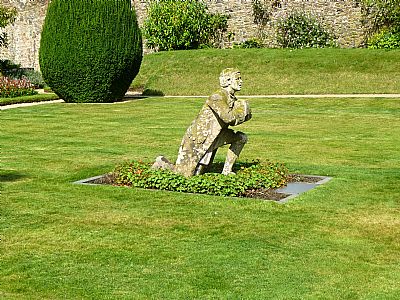
Morris, the devious exciseman from Sir Walter Scott’s novel Rob Roy. He is depicted begging forgiveness from Rob Roy’s wife Helen MacGregor for his involvement in her husband’s capture by the authorities.
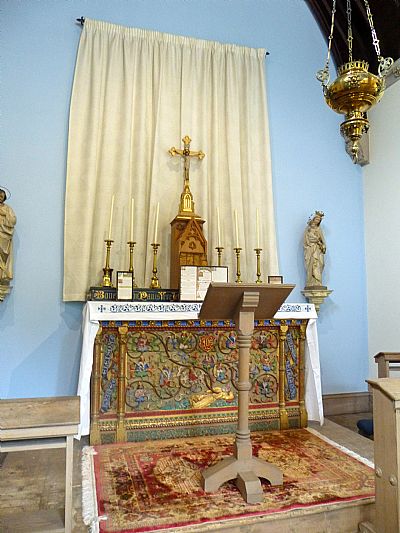
The Chapel at Abbotsford
After our tour of the house we had plenty of time to round off a memorable day by visiting the chapel, magnificent walled garden and exploring the rest of the grounds extending down to the banks of the Tweed.
.=====================================================
